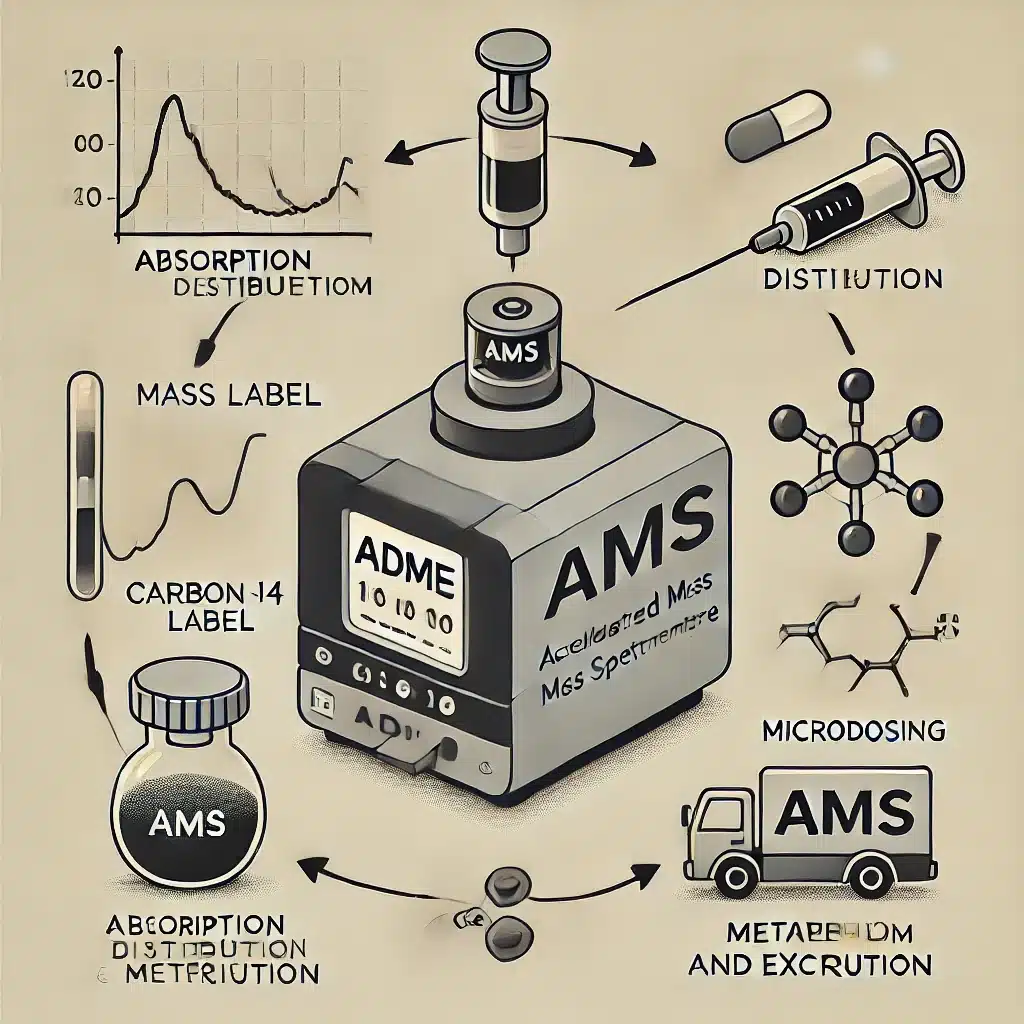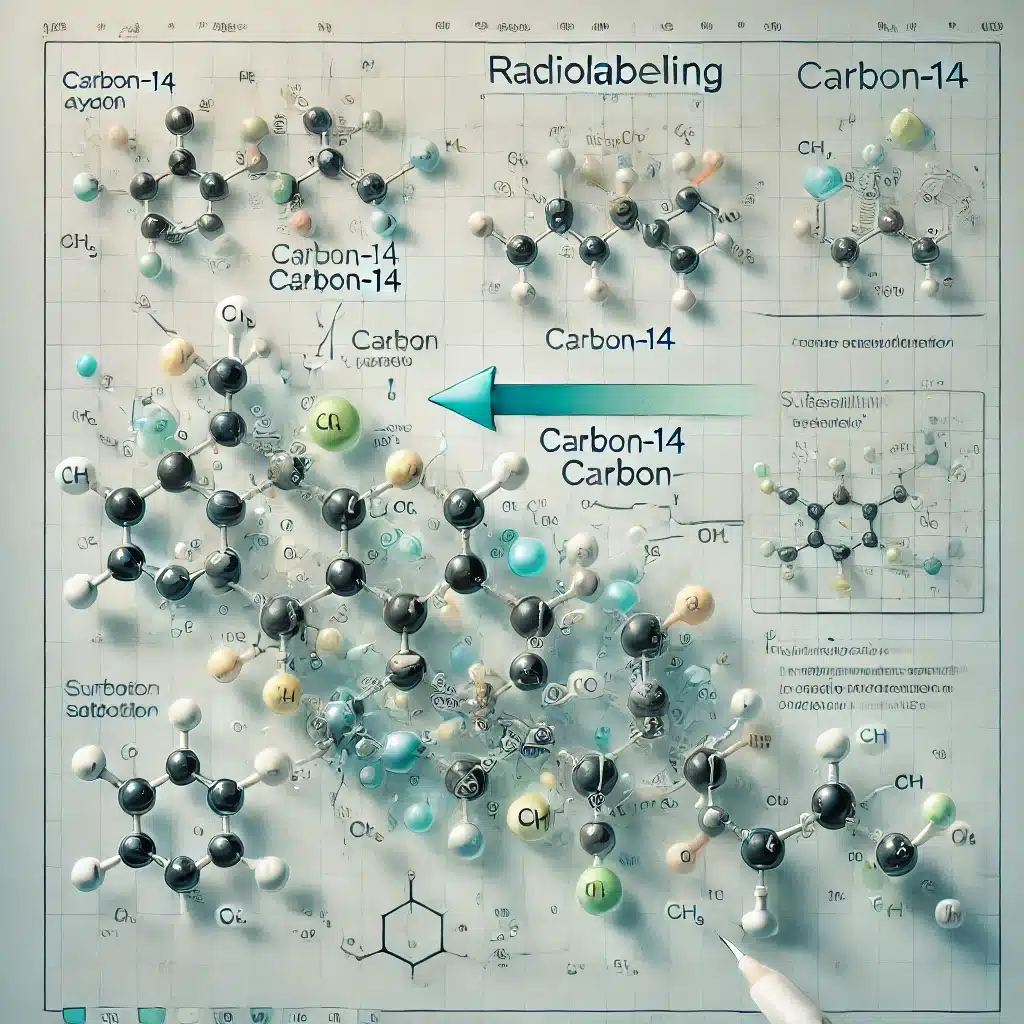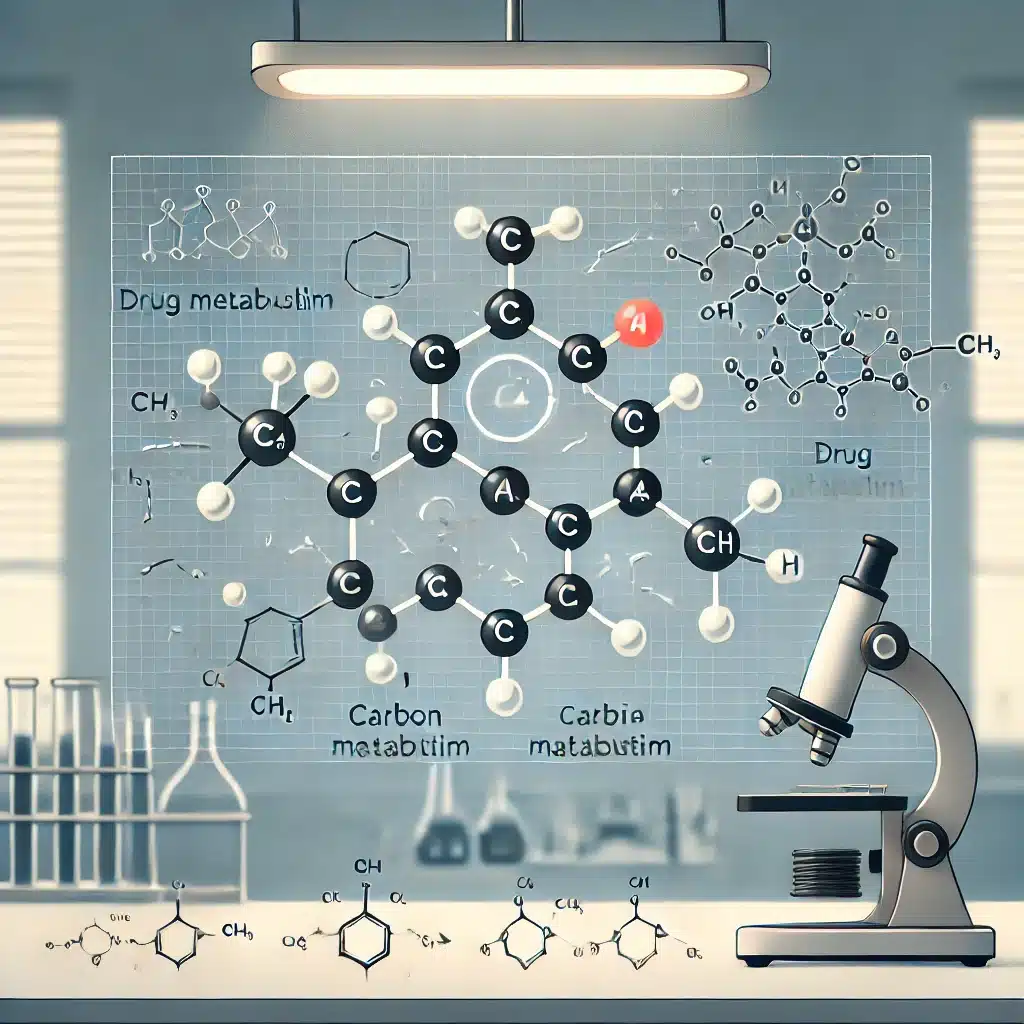Summary: Carbon-14 microtracers represent a pivotal advancement in biomedical and pharmaceutical research, offering precise tracking of biological processes at microdoses with minimal risk to subjects. Leveraging carbon-14, a naturally occurring radioactive isotope, scientists can safely examine drug absorption, metabolism, and interactions in the human body. This article explores the science behind carbon-14 microtracers, their application across fields, regulatory considerations, and their potential to shape future studies in a rapidly evolving scientific landscape.
Introduction to Carbon-14 Microtracers
Radioisotope tracers are essential in tracing molecular pathways, particularly in pharmaceutical and biochemical research. Carbon-14, a naturally occurring radioactive isotope, is particularly useful as a microtracer. The unique properties of carbon-14 allow for highly accurate tracking of molecules within biological systems, enabling researchers to observe how drugs are absorbed, metabolised, and excreted in humans and animals. This capacity for close monitoring has transformed our understanding of pharmacokinetics and pharmacodynamics.
Understanding the Basics of Carbon-14 Microtracers
What are Carbon-14 Microtracers?
A microtracer involves tagging a substance with a radioisotope—in this case, carbon-14—at a level low enough to avoid harmful effects but high enough to detect the tracer in biological samples. Carbon-14 microtracers are created by substituting a non-radioactive carbon atom within a molecule with a carbon-14 atom, enabling researchers to monitor the molecule’s journey through complex biological systems.
Carbon-14: A Unique Radioisotope
Carbon-14 decays over time, emitting beta particles with a half-life of around 5,730 years, making it a stable yet detectable tracer. The long half-life ensures consistent observation within the timeframe of most biological studies, and the low-energy beta emissions minimise health risks associated with radiation. These properties make carbon-14 highly suited for microtracing applications in clinical and non-clinical studies alike.
Applications of Carbon-14 Microtracers in Research and Industry
Carbon-14 microtracers have found applications across multiple disciplines, particularly in pharmacokinetics, environmental science, and nutritional studies. Below are several critical areas where carbon-14 microtracers have enabled advances.
Pharmacokinetics and Pharmacodynamics Studies
The pharmaceutical industry is heavily reliant on carbon-14 microtracers for tracing drug molecules in vivo. These studies provide valuable data on drug absorption, distribution, metabolism, and excretion (ADME), which are crucial in the early stages of drug development. By administering carbon-14-labelled drugs at microdoses, researchers can generate reliable data on a compound’s pharmacokinetics without exposing subjects to harmful doses.
Understanding Drug-Drug Interactions
In modern medicine, patients often take multiple drugs simultaneously, increasing the potential for interactions. Carbon-14 microtracers help researchers observe drug-drug interactions by tracking how one drug might affect the metabolism or activity of another. This capability is invaluable in ensuring patient safety and optimising therapeutic regimens in complex medical scenarios.
Environmental Impact Studies
Carbon-14 microtracers also offer insights into environmental processes, particularly in studying pollutant migration. In agriculture, microtracers are used to understand pesticide residues, while in ecology, they help trace the carbon cycles within ecosystems. These studies allow scientists to examine how substances degrade or persist in the environment, contributing to more sustainable practices.
Nutritional Research
Nutrition science benefits from carbon-14 tracers by enabling researchers to track how nutrients are metabolised in the human body. This method can reveal details about absorption rates, nutrient pathways, and overall metabolic efficiency, ultimately contributing to optimised dietary recommendations and interventions.
Safety and Ethical Considerations in Carbon-14 Microtracer Studies
While carbon-14 microtracers offer substantial advantages, ethical and safety concerns are paramount, particularly in studies involving human subjects. Researchers and regulators must carefully manage radioactivity exposure and ensure adherence to safety protocols to mitigate any potential risks.
Safety Protocols and Guidelines
In human trials, the use of carbon-14 microtracers must comply with international safety guidelines. The International Conference on Harmonisation (ICH) and the US Food and Drug Administration (FDA) provide frameworks for limiting radiation exposure to levels deemed acceptable for human research. Studies often involve microdosing, where the dose of carbon-14 used is well below the threshold for harm, allowing for safe human trials.
Ethical Approval Processes
All studies using carbon-14 microtracers require rigorous ethical review, particularly in human research. Regulatory bodies evaluate these studies to ensure the risk-to-benefit ratio is reasonable and that participants are informed of all risks. The ethical oversight aims to ensure that the use of radioactive materials in human subjects aligns with the highest standards of patient safety and scientific responsibility.
Regulatory Frameworks and Approval Process
International Regulations
Regulatory bodies globally impose strict controls on using radioactive materials in research, particularly in human trials. Agencies like the FDA, European Medicines Agency (EMA), and the UK Medicines and Healthcare products Regulatory Agency (MHRA) set limits on acceptable radiation doses in drug development studies.
Approval in Clinical Trials
To incorporate carbon-14 microtracers into clinical trials, pharmaceutical companies must demonstrate their necessity, the safety of participants, and compliance with regulatory standards. Regulators review studies to ensure that radiation exposure remains minimal, data accuracy is maximised, and patient safety is prioritised.
Advances in Detection Techniques
Detecting carbon-14-labelled compounds in biological samples requires sensitive and precise techniques. Advances in detection methods have significantly improved data quality and minimised sample sizes.
Accelerator Mass Spectrometry (AMS)
Accelerator Mass Spectrometry (AMS) is a leading detection technique for carbon-14 microtracers, offering unparalleled sensitivity. AMS enables researchers to measure carbon-14 at exceedingly low levels, making it suitable for microdose studies. The technology can detect tiny amounts of carbon-14 in blood, urine, and tissue samples, which reduces the need for larger samples and makes studies less invasive for participants.
Liquid Scintillation Counting (LSC)
Liquid scintillation counting (LSC) is a more traditional technique but remains widely used due to its reliability and cost-effectiveness. This method involves mixing a sample with a scintillation fluid that emits light when in contact with beta particles from carbon-14. LSC is commonly used in studies requiring moderate sensitivity, making it suitable for non-clinical research.
Advantages of Carbon-14 Microtracers in Biomedical Research
Minimised Health Risks
Compared to larger doses used in traditional radioisotope studies, carbon-14 microdoses significantly reduce the health risks to study participants. This capability is particularly valuable in early-phase clinical trials, where the safety of novel compounds is still uncertain.
High Sensitivity and Specificity
Carbon-14 microtracers provide a level of sensitivity and specificity that other tracers cannot achieve. The carbon atom’s role in organic chemistry allows for seamless integration into complex molecules, making it possible to trace entire metabolic pathways with precision.
Reduced Ethical Barriers
Due to the low levels of radiation exposure involved, ethical barriers are significantly lowered. As a result, obtaining regulatory approval for carbon-14 microtracer studies is more manageable than studies with higher-risk radioactive tracers.
Limitations and Challenges of Carbon-14 Microtracers
Technical Challenges
The detection of carbon-14 at extremely low levels requires sophisticated equipment and expertise. AMS, for instance, is a costly technique requiring specialised facilities, limiting its accessibility. These technical demands can make microtracer studies expensive and logistically complex.
Regulatory Constraints
Although the radiation dose is minimal, regulatory bodies require stringent controls on any use of radioactive materials. This can lead to longer approval timelines and higher compliance costs, particularly in clinical trials.
Limited Public Acceptance
The association of radiation with health risks has created some public hesitation around the use of carbon-14, even at microdose levels. Addressing these concerns requires effective communication of the minimal risk and significant benefits associated with microtracer studies.
Future Perspectives: The Role of Carbon-14 Microtracers in Next-Generation Research
As the field of molecular imaging and pharmacokinetics advances, carbon-14 microtracers are poised to play a central role. Emerging research areas, such as personalised medicine and targeted therapies, require precise data on how drugs interact within individual bodies. Carbon-14 microtracers offer the accuracy and safety needed to meet these demands.
Applications in Personalised Medicine
With personalised medicine rising, carbon-14 micro tracers offer a safe and effective way to observe individualised drug responses. Tailoring treatments based on microtracer data could lead to safer, more effective therapeutic strategies.
Expansion into Novel Therapeutic Areas
The versatility of carbon-14 microtracers enables their application in emerging therapeutic fields like gene therapy and biologics. These treatments often involve complex molecular pathways, where the microtracers’ ability to track movement at a molecular level can provide invaluable insights.
Enhanced Environmental Applications
Environmental science will also benefit from carbon-14 microtracer developments. As global concerns around pollution and sustainable agriculture intensify, carbon-14 offers a viable means of studying pollutant behaviour, organic matter cycles, and bioremediation efforts in natural environments. These applications are particularly valuable in developing sustainable practices, as carbon-14 microtracers can accurately identify how chemicals and organic compounds move and change in ecological systems. With climate change, pollution, and biodiversity loss at the forefront of global concerns, carbon-14 microtracers provide a powerful tool for investigating environmental dynamics, offering actionable insights to inform policy and conservation efforts.
Case Studies Highlighting the Use of Carbon-14 Microtracers
To illustrate the practical utility of carbon-14 microtracers, several notable case studies demonstrate how these tracers have advanced scientific understanding and informed critical research decisions.
Microdosing in Clinical Trials for New Drug Development
A major pharmaceutical company used carbon-14 microtracers to study a new drug’s pharmacokinetics in first-in-human trials. By labelling the compound with carbon-14 at a microdose, researchers could measure its absorption and clearance in the body without exposing participants to significant radiation or high drug levels. This approach provided early insights into the drug’s metabolism, allowing the team to refine dosages before larger trials. Consequently, the trial advanced more quickly and with greater safety assurances, reducing both time and cost for the development process.
Assessing Environmental Contamination from Agricultural Chemicals
An agricultural research institute conducted a study to assess the impact of a pesticide on surrounding ecosystems using carbon-14 microtracers. By labelling the pesticide molecules, the team tracked its dispersion and breakdown in soil and water sources over time. The study’s findings revealed how the pesticide degraded in specific environmental conditions and identified potential risks to non-target species. These insights guided regulatory recommendations, leading to safer application guidelines and modifications to the chemical formulation for reduced environmental impact.
Nutritional Studies on Metabolic Pathways of Key Nutrients
In a nutritional science study, researchers utilised carbon-14-labelled amino acids to observe metabolic pathways in patients with metabolic disorders. By tracking the carbon-14-labelled molecules through the body, the study highlighted deficiencies in specific metabolic enzymes, which helped refine dietary recommendations tailored to individual needs. This research underscored the role of carbon-14 microtracers in precision nutrition, enhancing our understanding of nutrient utilisation in different populations.
Carbon-14 Microtracers to Alternative Tracers
While carbon-14 is highly effective as a microtracer, other isotopes are sometimes used for similar purposes. Understanding the distinctions between carbon-14 and other tracers is important when selecting an approach for a particular study.
Carbon-14 vs. Carbon-13
Carbon-13 is a non-radioactive isotope used in stable isotope tracing, offering an alternative for studies where even low radiation exposure is unsuitable. However, carbon-13’s sensitivity is lower than carbon-14, limiting its usefulness in microdosing and certain pharmacokinetic studies where precise detection at ultra-trace levels is required. While carbon-13 remains valuable in non-radioactive applications, carbon-14 microtracers are preferred in studies requiring extreme sensitivity.
Comparison to Tritium (Hydrogen-3)
Tritium is another common radioisotope tracer used in biomedical research, particularly in DNA and RNA labelling. Tritium has a shorter half-life and higher radiation output than carbon-14, which restricts its use in human studies. Carbon-14, with its stable half-life and lower energy emissions, is thus safer for human-based research and better suited for long-term studies, while tritium is preferred in shorter-term cellular studies due to its higher decay rate.
Technical Innovations and Future Directions
The field of carbon-14 microtracers is evolving, with numerous innovations aimed at enhancing detection sensitivity, reducing costs, and expanding application scope. Advances in AMS technology, miniaturisation, and automation are driving the next generation of tracer studies.
Miniaturisation of Detection Equipment
Recent advancements in miniaturising AMS equipment promise to make high-sensitivity carbon-14 detection more accessible. Portable AMS units could allow in-lab analysis, removing the need to transport samples to specialised facilities. This development would accelerate data acquisition, improve cost-efficiency, and broaden the availability of carbon-14 microtracer studies across more research environments.
Development of New Labelling Techniques
Innovations in molecular labelling techniques are enhancing the versatility of carbon-14 tracers. Improved labelling strategies allow carbon-14 atoms to be incorporated into increasingly complex biomolecules with greater stability. This advancement expands the range of molecular targets suitable for carbon-14 microtracing, potentially including large proteins, biologics, and genetic material, which are crucial for next-generation therapeutic development.
Integration with Artificial Intelligence and Data Analytics
Combining carbon-14 microtracer data with artificial intelligence (AI) and machine learning (ML) is an emerging area of interest. AI and ML models can process vast datasets from microtracer studies, identifying patterns and generating predictive models. This integration could optimise study design, analyse complex pharmacokinetic behaviours, and improve decision-making in drug development and personalised medicine.
Concluding Remarks
Carbon-14 microtracers represent a transformative approach in scientific research, offering unparalleled sensitivity and specificity for tracking molecular pathways in a safe and efficient manner. From drug development and personalised medicine to environmental science and nutrition, carbon-14 tracers have paved the way for innovative solutions across multiple domains.
The evolution of detection techniques, regulatory frameworks, and technical advancements continues to expand the horizons of carbon-14 microtracing. As researchers refine their methodologies and adopt new technologies, the role of carbon-14 microtracers will likely grow, enabling deeper insights into the complexities of biological systems and fostering developments that prioritise both human and environmental health.
The versatility, safety, and precision of carbon-14 microtracers will ensure their continued relevance and importance in addressing some of the most pressing challenges in science and medicine. As this field progresses, the knowledge gained from carbon-14 microtracer studies will undoubtedly contribute to safer drugs, a healthier environment, and a more profound understanding of human biology in a rapidly changing world.
Disclaimer
The content of this article is intended for informational and educational purposes only and does not constitute professional medical, scientific, or regulatory advice. While every effort has been made to ensure the accuracy of the information provided, Open Medscience makes no representations or warranties regarding the completeness, reliability, or suitability of the content for any particular purpose.
The discussion of carbon-14 microtracer technology, its applications, and related safety or regulatory considerations reflects the current state of scientific understanding at the time of publication and may be subject to change as research progresses. Readers are advised to consult relevant experts, regulatory authorities, or professional bodies before relying on any information contained herein for clinical, research, or commercial use.
Open Medscience accepts no liability for any loss or damage resulting from reliance on the information in this article. The inclusion of case studies and references to specific techniques or technologies does not imply endorsement or recommendation.
Use of radioactive materials, including carbon-14, is subject to stringent regulatory control. All research involving such materials must comply with applicable national and international laws and undergo appropriate ethical review.
You are here: home » diagnostic medical imaging blog »



